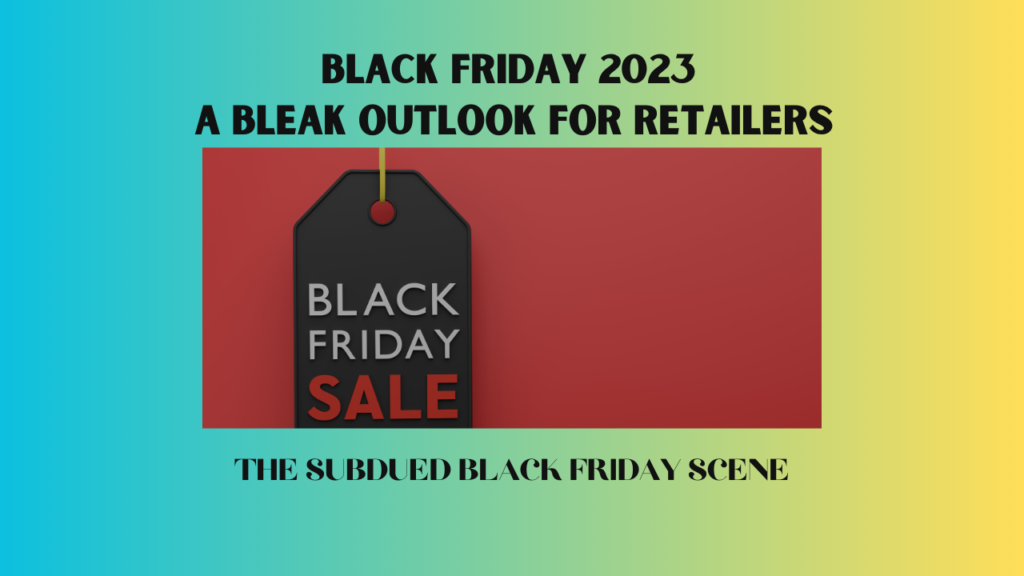As the dust settles on this year’s Black Friday, a resounding shift is evident – the frenzy seems to have quieted down. The traditional image of shoppers racing through store aisles and camping outside for the best deals has given way to a more subdued scene. What does this quieter Black Friday mean for consumers, retailers, and the overall holiday shopping season? Let’s unravel the insights and trends shaping this evolving retail landscape.

The Subdued Black Friday Scene
This Black Friday, the rush to grab discounted electronics, clothing, and household goods seemed notably tamer compared to previous years. Analysts at TD Cowen revised their U.S. holiday spending estimate downwards, signaling a shift from the anticipated 4% to 5% growth to a more modest 2% to 3%. The Black Friday excitement appeared dampened, with October and November discounts potentially stealing its thunder.
David Klink, a senior analyst at Huntington Private Bank, pointed out a compelling perspective – people might already have what they want. The saturation of big-screen TVs and Amazon’s voice assistants, Alexa, has possibly lessened the allure of Black Friday deals.
The Impact of Economic Pressures
In the backdrop of persistent inflation and high interest rates, consumers are feeling the pinch. U.S. holiday spending is poised to increase at the slowest pace in five years. The cautious approach of consumers, coupled with the robust performance of discount retailers like Target and Ross Stores, reflects concerns over the cost of living, even as recession fears ease.
Barbara Kahn, a professor at The Wharton School at the University of Pennsylvania, notes a shift in consumer behavior. People are more value-conscious and are approaching spending with a conservative mindset. The cautious stance is not just a blip on the radar; it’s a reflection of the ongoing economic uncertainties.
A Global and Online Black Friday
The Black Friday tradition, born in the U.S., has transcended borders and moved online. The rise of e-commerce has reshaped Black Friday from a single-day, in-store event to a global and digital phenomenon. This shift is evident in the record-breaking $7.3 billion spent online on Black Friday, a 7.4% increase from the previous year.
The excitement of waiting in lines for Black Friday deals has dwindled. Jimmy Lee, CEO of The Wealth Consulting Group, suggests that people are now opting to find deals from the comfort of their homes. The traditional fervor associated with Black Friday seems to be making way for a more convenient and digital approach to holiday shopping.
Deeper Discounts and Consumer Skepticism
To counter the subdued shopping atmosphere, retailers are resorting to deeper discounts and early promotions. Macy’s, Amazon, and others initiated deals as early as October, with the promise of additional discounts closer to Christmas. However, the big question looms – will these deals be enough to entice consumers, particularly those weary of inflation and economic uncertainties?
Best Buy, for example, is offering significant discounts on electronics, acknowledging that consumers are holding off on big-ticket purchases. Luxury spending downturns have prompted high-end department stores to slash prices, but the response from consumers is mixed. Some shoppers find the deals less enticing than in previous years, signaling a shift in the perception of what constitutes a true bargain.
Black Friday Beyond Shopping: Sporadic Protests
This year’s Black Friday took place amid a four-day Israel-Hamas truce, and it wasn’t just about shopping. Across the United States, sporadic protests with the theme “shut it down for Palestine” unfolded. Demonstrators staged events, including a die-in at a Dallas mall and temporary shutdowns at various locations. Brands like Puma found themselves in the crossfire, with protesters accusing them of supporting the Israel Football Association.
In the midst of discounts and deals, these protests remind us that Black Friday carries weight beyond consumerism. It becomes a platform for various voices and causes to be heard.
Conclusion: Navigating the New Normal of Black Friday
As we reflect on this year’s Black Friday, it’s evident that the landscape is evolving. The once thunderous event has adopted a quieter tone, reflecting shifting consumer behaviors, economic pressures, and the ever-expanding reach of online shopping. Retailers are adapting with deeper discounts, early promotions, and a prolonged shopping season.
For consumers, this signals a new normal in holiday shopping – one that blends the traditional thrill of discounts with a more considered and digital approach. As we navigate these changes, the essence of Black Friday, with its mix of consumer excitement and societal statements, continues to be a fascinating aspect of our evolving retail culture.
